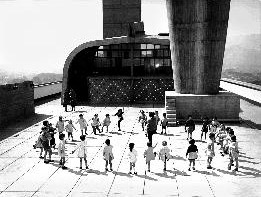
| HOME |
| NERVE |
| REVIEWS |
| ARCHIVE |
| EVENTS |
| LINKS |
| ABOUT US |
| CONTRIBUTORS |
| BACK ISSUES |
| CONTACT US |
 Le Corbusier:
The Art of Architecture
Le Corbusier:
The Art of Architecture
The Crypt, Metropolitan Cathedral
2nd October 2008 – 18th January 2009
Reviewed by Alfonso Barata
Organised by the Royal Institute of British Architects Trust, this is a unique opportunity to enter the world of one of the most - if not the most - influential architects of the twentieth century and whose work has been copied and adapted time and time again, sometimes with disastrous consequences, as British architecture knows all too well.
Born Charles-Edouard Jeanneret in Switzerland at the end of the nineteenth century, Le Corbusier quickly became a reference not just within the architectural world but also with the wider creative and revolutionary forces that populated Paris at the dawn of the new century, then the artistic capital of the world.
Le Corbusier’s designs and ideas transformed architecture in the same way Picasso’s changed modern painting forever.
Fittingly, the exhibition - which looks and examines key aspects of his work and life - takes place in the vaulted rooms of the Metropolitan Cathedral’s Crypt, which for the first time is hosting a major exhibition.
The Crypt’s vaulted ceilings, which is the only remaining part of a design for a planned cathedral that did not happen, is a stark contrast to Le Corbusier’s ideas of space, light and order and it is this disparity that makes even more obvious the transformation in the way buildings should be designed that Le Corbusier was proposing at about the same time this nonetheless impressive crypt was being built.
Divided into three main sections- Contexts, Privacy and Publicity and Built Art - the exhibition showcases a number of Le Corbusier’s drawings, sketches, watercolours, models, short films and paintings, thus presenting us with a lesser known aspect of his life: an artist also interested in other disciplines beyond architecture.
Le Corbusier’s theoretical ideas regarding mass-housing - perfectly exemplified in the building Unite D’habitation - were keenly adapted by politicians and planners, who in the wake of the Second World War felt this was a solution to the housing problem.
Unfortunately, cheap copies and adaptations of his original idea sprung like mushrooms in many countries and cities, Britain and Liverpool included, giving way to an infamous building spree that dotted cities with ugly and flawed buildings.
The problem I see with exhibitions about any architect’s retrospective is that they do not normally show the aesthetic impact and relevance of a building at its finest, simply because the best way of appreciating this is actually visiting the building in situ.
So for someone to be able to get a good idea of the radical transformation and beauty proposed in buildings such as Ville Savoye or the Ronchamp Chapel, the ideal would be to go to Poissy or Ronchamp in France.
This exhibition - which is presented as part of Liverpool’s European Capital of Culture celebration - will be of interest especially for anyone who, already familiar with Le Corbusier’s work, wants to explore more his influence and approach towards architecture and society in the past century.
Likewise, architects, urban planners and local politicians should visit it and, more importantly, take note for Liverpool has not been immune to all that went wrong with architecture and urbanism over the past decades.
Comments:
Comment left by Sandra Gibson on 11th December, 2008 at 11:37
I absolutely agree - especially the points about the vaulted building as counterpoint to Le Corbusier's approach to architecture and the problem of not experiencing the actual buildings in an exhibition such as this.
I thought it was an astonishing collection and had not realised what an eclectic and brilliant mind he had. My mind had been soured by post-war urban renewal but I now realise I was not seeing the whole picture.
I enjoyed this review.